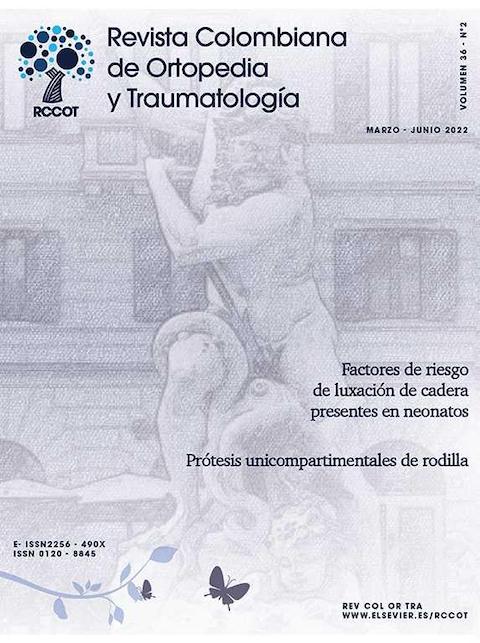Desenlaces clínicos y radiológicos de pacientes con deslizamiento epifisiario capital femoral según el tipo de tratamiento
DOI:
https://doi.org/10.1016/j.rccot.2022.06.005Palabras clave:
radiografía, epífisis desprendida de cabeza femoral, caderaResumen
Introducción: El deslizamiento epifisiario capital femoral (DECF), es una patología sin consenso en su tratamiento y con tasas de complicación variables según la técnica empleada.
Materiales y métodos: Descripción del desenlace clínico y radiológico de una cohorte de pacientes con diagnóstico de DECF tratados en nuestra institución entre 2012 y 2015. Se evaluó la asociación entre las características clínicas y el desenlace de necrosis avascular de la cabeza femoral (NAV) calculando el RR crudo y ajustado de Mantel- Haenszel.
Resultados: Se incluyeron 71 pacientes, edad media de 13,1 años, el ángulo de Southwick prequirúrgico fue 46,9◦ (12◦-100◦). Dieciséis casos fueron deslizamiento leve (22,5%), 38 casos moderados (53,5%) y 17 casos severos (23,9%). Se encontraron 6 casos de NAV con luxación controlada (23% o 24%) y un caso con las técnicas percutáneas (2,2%) (p=0,05).
Conclusión: No se encontró asociación entre las variables de edad, IMC y sexo con la presentación de NAV. Existe una asociación entre este desenlace y la técnica quirúrgica empleada.
Nivel de evidencia: III Estudio de cohorte retrospectiva
Descargas
Referencias bibliográficas
Castillo C, Mendez M. Slipped capital femoral epiphysis: A review for pediatricians. Pediatr Ann. 2018;47:e377-80, http://dx.doi.org/10.3928/19382359-20180730-01.
Mathew SE, Larson AN. Natural history of slipped capital femoral epiphysis. J Pediatr Orthop. 2019;39 6, Supplement 1 Suppl 1:S23-7, http://dx.doi.org/10.1097/BPO.0000000000001369.
Navarre P. Slipped capital femoral epiphysis: A review of the New Zealand literature. J Bone Joint Surg Am. 2020;102 Suppl 2:8-14, http://dx.doi.org/10.2106/JBJS.20.00066.
Hellmich HJ, Krieg AH. Epiphyseolysis capitis femoris - Ätiologie und Pathogenese. Orthopade. 2019;48:644-50, http://dx.doi.org/10.1007/s00132-019-03743-4.
Aprato A, Conti A, Bertolo F, Massè A. Slipped capital femoral epiphysis: current management strategies. Orthop Res Rev. 2019;11:47-54, http://dx.doi.org/10.2147/ORR.S166735.
Erden T, Pehlivan AT. Outcomes of fixation of slipped capital femoral epiphysis with single cannulated screw. Eamr. 2021;37:153-7, http://dx.doi.org/10.4274/eamr.galenos.2020.05025.
Cheok T, Smith T, Berman M, Jennings M, Williams K, Poonnoose PM, et al. Is the modified Dunn’s procedure superior to in situ fixation? A systematic review and meta-analysis of comparative studies for management of moderate and severe slipped capital femoral epiphysis. J Child Orthop. 2022;16:27-34, http://dx.doi.org/10.1177/18632521221078864.
Masquijo JJ, Allende V, D’Elia M, Miranda G, Fernández CA. Treatment of slipped capital femoral epiphysis with the modified Dunn procedure: A multicenter study. J Pediatr Orthop. 2019;39:71-5, http://dx.doi.org/10.1097/bpo.0000000000000936.
Mooney JF, Sanders JO, Browne RH, Anderson DJ, Jofe M, Feldman D, et al. Management of unstable/acute slipped capital femoral epiphysis: Results of a survey of the POSNA membership. J Pediatr Orthop. 2005;25:162-6, http://dx.doi.org/10.1097/01.bpo.0000151058.47109.fe.
Witbreuk M, Besselaar P, Eastwood D. Current practice in the management of acute/unstable slipped capital femoral epiphyses in the United Kingdom and the Netherlands: results of a survey of the membership of the British Society of Children’s Orthopaedic Surgery and the Werkgroep Kinder Orthopaedie. J Pediatr Orthop B. 2007;16:79-83, http://dx.doi.org/10.1097/01.bpb.0000236234.64893.92.
Thawrani DP, Feldman DS, Sala DA. Current practice in the management of slipped capital femoral epiphysis. J Pediatr Orthop. 2016;36:e27-37, http://dx.doi.org/10.1097/bpo.0000000000000496.
Ziebarth K, Milosevic M, Lerch TD, Steppacher SD, Slongo T, Siebenrock KA. High survivorship and little osteoarthritis at 10-year followup in SCFE patients treated with a modified Dunn procedure. Clin Orthop Relat Res. 2017;475:1212-28, http://dx.doi.org/10.1007/s11999-017-5252-6.
Bittersohl D, Bittersohl B, Westhoff B, Krauspe R. Slipped capital femoral epiphysis: clinical presentation, diagnostic procedure and classification. Orthopade. 2019;48:651-8, http://dx.doi.org/10.1007/s00132-019-03767-w.
Naseem H, Chatterji S, Tsang K, Hakimi M, Chytas A, Alshryda S. Treatment of stable slipped capital femoral epiphysis: systematic review and exploratory patient level analysis. J Orthop Traumatol. 2017;18:379-94, http://dx.doi.org/10.1007/s10195-017-0469-4.
Parsch K, Weller S, Parsch D. Open reduction and smooth Kirschner wire fixation for unstable slipped capital femoral epiphysis. J Pediatr Orthop. 2009;29:1-8, http://dx.doi.org/10.1097/BPO.0b013e318180ea3.
Hernigou P, Poignard A, Nogier A, Manicom O. Fate of very small asymptomatic stage-i osteonecrotic lesions of the hip. J Bone Joint Surg Am. 2004;86:2589-93, http://dx.doi.org/10.2106/00004623-200412000-00001.
Nam KW, Kim YL, Yoo JJ, Koo K-H, Yoon KS, Kim HJ. Fate of untreated asymptomatic osteonecrosis of the femoral head. J Bone Joint Surg Am. 2008;90:477-84, http://dx.doi.org/10.2106/JBJS.F. 01582.
Gomez JA, Matsumoto H, Roye DP, Vitale MG, Hyman JE, van Bosse HJP, et al. Articulated hip distraction: A treatment option for femoral head avascular necrosis in adolescence. J Pediatr Orthop. 2009;29:163-9, http://dx.doi.org/10.1097/bpo.0b013e31819903b9.
Sinha P, Khedr A, McClincy MP, Kenkre TS, Novak NE, Bosch P. Epiphyseal translation as a predictor of avascular necrosis in unstable slipped capital femoral epiphysis. J Pediatr Orthop. 2021;41:40-5, http://dx.doi.org/10.1097/BPO.0000000000001690.
Kennedy JG, Hresko MT, Kasser JR, Shrock KB, Zurakowski D, Waters PM, et al. Osteonecrosis of the femoral head associated with slipped capital femoral epiphysis. J Pediatr Orthop. 2001;21:189-93, http://dx.doi.org/10.1097/01241398-200103000-00011.
Ziebarth K, Domayer S, Slongo T, Kim Y-J, Ganz R. Clinical stability of slipped capital femoral epiphysis does not correlate with intraoperative stability. Clin Orthop Relat Res. 2012;470:2274-9, http://dx.doi.org/10.1007/s11999-012-2339-y.
Casey BH, Hamilton HW, Bobechko WP. Reduction of acutely slipped upper femoral epiphysis. J Bone Joint Surg Br. 1972;54- B:607-14, http://dx.doi.org/10.1302/0301-620x.54b4.607.
Kitano T, Nakagawa K, Wada M, Moriyama M. Closed reduction of slipped capital femoral epiphysis: High-risk factor for avascular necrosis. J Pediatr Orthop B. 2015;24:281-5, http://dx.doi.org/10.1097/bpb.0000000000000170 c¸.
Palocaren T, Holmes L, Rogers K, Kumar SJ. Outcome of in situ pinning in patients with unstable slipped capital femoral epiphysis: assessment of risk factors associated with avascular necrosis. J Pediatr Orthop. 2010;30:31-6, http://dx.doi.org/10.1097/BPO.0b013e3181c537b0.
Kaewpornsawan K, Sukvanich P, Eamsobhana P, Chotigavanichaya C. The most important risk factors for avascular necrosis and chondrolysis in patients with slipped capital femoral epiphysis. J Med Assoc Thai. 2014;97 Suppl 9:S133-8.
Herngren B, Stenmarker M, Vavruch L, Hagglund G. Slipped capital femoral epiphysis: a population-based study. BMC Musculoskelet Disord. 2017;18(1.), http://dx.doi.org/10.1186/s12891-017-1665-3.









